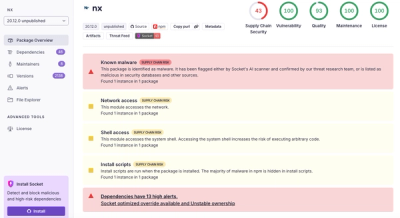
Security News
Nx npm Packages Compromised in Supply Chain Attack Weaponizing AI CLI Tools
Malicious Nx npm versions stole secrets and wallet info using AI CLI tools; Socket’s AI scanner detected the supply chain attack and flagged the malware.
@invisible/deploy
Advanced tools
Module to help deploy and run Google App Engine projects with features like:
npm install @invisible/deploy
# or
yarn add @invisible/deploy
Make sure to install as a normal dependency, since part of it is run on the deployed instance, and dev-dependencies are not installed on production.
gcloud sdk https://cloud.google.com/sdk/downloadsgcloud auth logingcloud app create --project=your-project-id --region=us-central.env file in your project's root folder.
Add your GCLOUD_PROJECT environment variable to it. Don't set PORT in your staging/.env or production/.env, GAE will set this for you.GCLOUD_PROJECT=gae-project-id-1a6std
This will be used to sync your local storage files to the bucket.
Run ./node_modules/.bin/deploy setup to create the backend bucket on Google Cloud.
Create a folder named storage on your project's root folder. Inside this folder you should have one folder for each services you want to deploy.
In each folder you should store the files you want to sync in your instances.
// Storing environment files for production and staging:
storage
├── production
│ └── .env
└── staging
└── .env
Add storage to your .gitignore file.
Create an GAE yaml config file for each environment you want to have.
# production.yaml
service: default
runtime: nodejs
env: flex
skip_files:
- ^node_modules$
- ^ignore$
- ^.env$
# staging.yaml
service: staging
runtime: nodejs
env: flex
skip_files:
- ^node_modules$
- ^ignore$
- ^.env$
manual_scaling:
instances: 1
prestart hook on package.json:// package.json
"scripts": {
"prestart": "./node_modules/.bin/sync",
...
}
Make sure you already have a default service running before you deploy any other. You can deploy to production with ./node_modules/.bin/deploy production.
If you are experience a bug, it might be a problem with the --quiet flag, so try running the command
gcloud app deploy production.yaml --project=your-project-id --promote
Usage:
deploy [setup|download|static|production|staging|branchName]
Argument can be:
setup
Creates the default backend bucket for this project.
download
Downloads all static files from the backend bucket.
static
Uploads all static files to the backend bucket.
branchName
Uploads branch static files and deploys the App to Google App Engine based on branchName.yaml file.
Usage: Add ./node_modules/.bin/sync as the value of scripts.prestart on your package.json.
Retrieve files from your project's backend bucket and place it on current instance's root folder.
FAQs
Module to help deploy and run Google App Engine projects.
The npm package @invisible/deploy receives a total of 9 weekly downloads. As such, @invisible/deploy popularity was classified as not popular.
We found that @invisible/deploy demonstrated a not healthy version release cadence and project activity because the last version was released a year ago. It has 8 open source maintainers collaborating on the project.
Did you know?

Socket for GitHub automatically highlights issues in each pull request and monitors the health of all your open source dependencies. Discover the contents of your packages and block harmful activity before you install or update your dependencies.

Security News
Malicious Nx npm versions stole secrets and wallet info using AI CLI tools; Socket’s AI scanner detected the supply chain attack and flagged the malware.

Security News
CISA’s 2025 draft SBOM guidance adds new fields like hashes, licenses, and tool metadata to make software inventories more actionable.

Security News
A clarification on our recent research investigating 60 malicious Ruby gems.